CESR Blog
Northwestern Center for Engineering Sustainability and Resilience faculty are developing new technologies that will enhance societal sustainability. In this blog, they, along with the students and post-docs within their groups, will describe these advances in the context of current events, societal trends, and technology developments at NU and around the world.
Please send all blog entries for posting to Eunae Jo eunae.jo@northwestern.edu
Capacitive Deinoization as an Affordable and Low-carbon Energy Desalination Alternative to Reverse Osmosis
Posted: April 30, 2020
Paolo Ramos and Jeffrey Richards
Department of Chemical & Biological Engineering, Northwestern University
The twenty-first century will be marked by the way that industrialized nations across the globe respond to a changing climate and to the reduced capacity of the environment to provide critical services.[1] In response to these challenges, new infrastructure investment must be considered to ensure access to low-carbon electricity and a sustainable supply of drinking water. To address the latter, desalination facilities have been proliferating in the US, particularly in the drought prone southwest.[2]
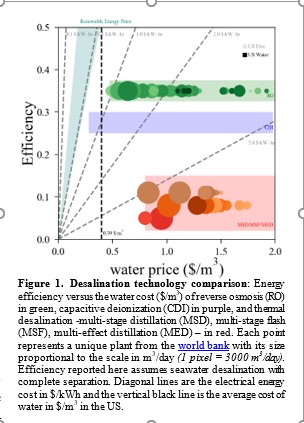
Despite the maturity of desalination technologies world-wide, generating potable water requires a vast amount of energy due in part to the high intrinsic energy cost 0.7 kW·hr/m3.[3] While reverse osmosis (RO) facilities in the US operate at high efficiency (~40%), they primarily utilize carbon-derived electricity to generate the high-pressures necessary to perform the separation. As the demand to reduce the carbon-footprint of energy intensive technologies increases, US desalination facilities will need to consider a transition toward renewable (wind/solar) electricity. A major challenge with this approach is shown in figure 1. Commercial solar and wind installations produce electricity at $0.25-0.54/kW·hr, which currently represents almost 50% of the average water sales price for the best performing RO technology.
With the right technology, this cost can at least in part be offset by recovering some of the input electrical energy. Capacitive Deionization (CDI) is an emerging technology that is thought to have comparable scalability and economics to RO, though with slightly lower separation efficiency. The advantage of CDI is that the electrical energy can be partially recovered in the form of electrical power. By selling this recovered electricity back to the grid or alternatively recycling it back into the separation process, the high energy costs of desalination can be partially offset. Full realization of this technology could also increase grid-capacity for renewable energy by producing potable water during periods of excess renewables supply and selling recovered electricity back to the grid during times of deficiently.
This case is made more compelling when we examine the embodied energy cost of desalinating sea water for San Diego county. The intrinsic energy required to generate 1 L of potable water using modern CDI technology from the Pacific Ocean is about 0.04 MJ. This value could increase to 0.4 MJ with increasing water salinity. In 2018, San Diego county consumed roughly 450,000 acre-feet of potable water for industrial and residential use.[4] If all potable water were supplied solely from CDI desalination, the annual minimum energy required would approach 5736 GW·hr. This is 30% of the 19,800 GW·hr of electrical energy consumed by San Diego county in the same year.[5] For certain CDI processes, regeneration of the electrodes yields 40% of the energy input of recovered electricity. Therefore, a CDI plant with the scale necessary to provide potable water to San Diego county could serve as a power-storage facility with a maximum capacity of 654 MW. Equivalent to a modest-size coal-fired power plant, this CDI plant can similarly supply electricity on demand, offering flexible grid-scale energy storage for wind and solar generation platforms.
Based on these estimates, we can determine whether it would be more economical to sell the excess electrical energy to the grid or instead recycle it back to the electricity inlet stream. The average electricity price for San Diego county was 0.24$/kW·hr, leading to a 2.4 $/m3 cost to generate potable water in a pure energy analysis.[6] If we recycle the recovered electrical energy from electrode regeneration, the cost drops to 1.48 $/m3. Compare these two values to the actual average cost of water which was 2.25 $/m3. At scale, a profit can only be made by recycling the excess electrical energy supply. Further analysis reveals, however, that if we instead sold the excess energy back to San Diego county, we would see a maximum 40% increase in annual profit. A preference in either scenario is thus highly dependent on local utility price rates. Figure 2 illustrates the CDI model for three California counties. Fully investing the recovered electrical energy into generating potable water in San Francisco creates a higher profit margin than selling it due to the large difference in water rates. On the other hand, the best option in Los Angeles would be to sell the recovered energy back to the grid due to the low water price. Doing so creates the highest profit out of all three counties, as Los Angeles consumed more than twice the electricity of San Diego and San Francisco combined.
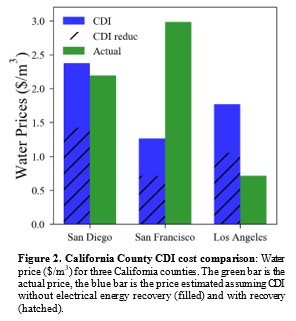
RO desalination facilities govern almost 60% of the installed desalination capacity we see today. Therefore, to evaluate the potential of CDI, a comparison to preexisting RO plants is necessary. To make a fair comparison, capital (CAPEX) and operating (OPEX) expenditures must be considered. Desalination costs depend on several factors including location, raw water quality, expected product quality, energy recovery, electrical power, and local infrastructure costs. Therefore, we have chosen to compare a hypothetical CDI installation in San Diego county to the Claude "Bud" Lewis Carlsbad Desalination Plant in Carlsbad, CA. The seawater RO plant established in 2015 is contracted for 30 years with The San Diego County Water Authority in providing 56,000 acre-feet/yr of potable water with a salination quality of 200 ppm. The water quantity and quality from this project along with local electricity intake and costs will be utilized with the technoeconomic CDI model produced by Hand et. al.[7] Calculations show that a full-scale CDI plant would require 22,600,000 cell pairs to reduce the salinity of the influent seawater from 36,000 to 200 ppm, amassing a total of 209,000 kg of active material. From these estimates, the capital cost of generating the same amount of water yearly as the project agreement would be around $212 million. Taking the intrinsic energy needed to desalinate water we determined beforehand with a 40% energy recovery, operational costs lands at about $8.8 million annually. From the CAPEX and OPEX, we calculate the total equivalent cost (EAC) at different lifetimes normalized to the annual water production in order to determine the cost of water. For a CDI plant with a lifetime of 2 to 30 years, the cost of water falls from 1.73 $/m3 to 0.28 $/m3 which is shown in Figure 1. As it stands, the Carlsbad Desalination Plant has an estimated water production cost of 1.83 $/m3.[8] Our technoeconomic analysis shows that a CDI plant with the capacity and capability to perform the same desalination requirements of the San Diego RO plant results in cheaper water cost for the total time frame of the project contract.
Further differences in the water production cost between the two plants comes from the stipulation that our model did not account for pumping, land, piping, and infrastructure costs. The capital cost of constructing the Carlsbad Desalination Plant was about $904 million. If we match this CAPEX to our CDI model, the cost of water would rise by 300%. At a lifetime of 9 years, the water production cost is 1.80 $/m3, below the projected cost for the Carlsbad plant. The quicker reduction in cost originates from the lower OPEX of our CDI model, as it is 6 times cheaper than the OPEX of the Carlsbad plant of $53 million per year. This estimate aligns well with our expectations as the total cost of a CDI plant should asymptote toward the raw active material and electricity cost at scale.
As drinking water is projected to double in price for urban areas over the next decade, the need for affordable sources of potable water supplies in water scarce regions of the US. Desalination plants will likely continue to provide a partial solution particularly to supplement the potable water of urban areas with high population densities. CDI technology compares favorably with RO and offers an affordable infrastructure investment to meeting our growing demand for low-carbon energy and water for the future.
CESR Seed funding supports new collaboration to study sustainable chemistry in electrocatalytic reactors
Posted: December 2, 2019
Niall Mangan (Northwestern, Applied Mathamatics) and
Linsey Seitz (Northwestern, Chemical & Biological Engineering)
We are excited about our new collaborative project, which will be supported by the first round of CESR seed funding this year. As new faculty, we were both looking to develop our research programs into new areas which could make a difference in sustainability. Even as renewable energy sources for electricity, such as wind and solar, have expanded, areas of industry such as industrial chemical production still rely on carbon-intensive processes for most products. Our collaboration seeks to improve our understanding of electrocatalytic processes so that we can engineer new devices for sustainable chemistry. Electrocatalytic processes can produce liquid fuels and chemical products from sustainable feedstocks and electricity. This could allow us to capitalize on the gains in renewable electricity penetration to drive the sustainable production of a large variety of chemical products. Such technologies would also enable electricity providers to buffer their intermittent energy production by producing chemicals or storable fuels during periods when electricity supply from wind or solar sources exceeds direct electricity demands, and then using these fuels when energy demand exceeds supply. Such flexibility can improve the financial incentives to install more photovoltaics and wind turbines for capture of these renewable energy sources.
Many researchers are working on electrocatalysis for these reasons. Unfortunately, exciting opportunities for electrocatalytic technologies are limited by our understanding of the complex relationships between bulk reactor properties and the local catalyst environment which influences  reaction efficiency and selectivity towards desired products. These problems are challenging because there is a complex interaction between the bulk transport or flow in the device, the chemical reactions, small charged species, and the electrical field near the catalyst surface. These processes happen on length scales of millimeters to nanometers, so it can be difficult to capture all the effects and the coupling between them in one model. We will use multi-scale modeling in Niall’s group and controlled experiments in Linsey’s group to study the coupling and behavior of the system. By understanding how the effects influence each other, we will be able to design robust chemical reactors and bridge the gap between carefully controlled laboratory catalyst environments and operational electrocatalytic reactors. CESR seed funding will enable us to investigate electrocatalytic production of hydrogen peroxide, as a sustainable alternative to the current industrial process, which is energy intensive and produces significant waste. Hydrogen peroxide is an environmentally friendly oxidant that is used in large quantities for a variety of industries, including water treatment. Through this work, we will build fundamental understanding of electrocatalytic reactors that can be extended to other reactions and develop technologies for effective coupling of renewable electricity from wind and solar to sustainable production of fuels and chemicals.
reaction efficiency and selectivity towards desired products. These problems are challenging because there is a complex interaction between the bulk transport or flow in the device, the chemical reactions, small charged species, and the electrical field near the catalyst surface. These processes happen on length scales of millimeters to nanometers, so it can be difficult to capture all the effects and the coupling between them in one model. We will use multi-scale modeling in Niall’s group and controlled experiments in Linsey’s group to study the coupling and behavior of the system. By understanding how the effects influence each other, we will be able to design robust chemical reactors and bridge the gap between carefully controlled laboratory catalyst environments and operational electrocatalytic reactors. CESR seed funding will enable us to investigate electrocatalytic production of hydrogen peroxide, as a sustainable alternative to the current industrial process, which is energy intensive and produces significant waste. Hydrogen peroxide is an environmentally friendly oxidant that is used in large quantities for a variety of industries, including water treatment. Through this work, we will build fundamental understanding of electrocatalytic reactors that can be extended to other reactions and develop technologies for effective coupling of renewable electricity from wind and solar to sustainable production of fuels and chemicals.
CESR convenes sustainability research and education in McCormick and beyond
Posted; November 11, 2019
Jennifer Dunn, CESR Associate Director
Undoubtedly, engineering is a foundational discipline in advancing society towards sustainability and increasing its resilience. Within the McCormick School of Engineering at Northwestern, several research groups and centers target these aims and many individual faculty members conduct research in areas essential to sustainability. Northwestern’s Center for Engineering Sustainability and Resilience (CESR) was established in early 2019 to connect these efforts that involve faculty, staff, and students to strengthen and amplify them. CESR will serve as a convener and a central resource for information on sustainability-related courses, seminars, outreach, degree programs, and activities.
As CESR has taken flight, Bill and I have met with an ever-growing list of faculty, students, staff, and external partners who want to build this community. As an example, we recently met Greg Kozak, the Director of Northwestern’s Office of Sustainability who spearheads efforts to increase energy efficiency at the University and reduce campus waste, among many other initiatives. We talked about ways CESR and his organization, sustainNU, can collaborate so NU engineering students and faculty can apply their know-how to addressing sustainability challenges in our back yard. Additionally, this summer we hosted 150 people from community groups, industry, government and academia to discuss sustainable urban systems and develop a research agenda to advance them. This NSF-funded event, Sustainable Urban Systems: Predictive, Integrated, Resilient, and Evolving (SUSPIRE) was a collaboration among CESR, Illinois CURES, Argonne National Laboratory, and the University of Chicago. Furthermore, we’ve talked with faculty in our seven focus areas to identify where research interests lie. We’re compiling a list of sustainability-related course work for students so they can have a one-stop shop for this information. We talked with faculty about their “dream” seminar invitees in sustainability and resilience so we can learn from these experts while familiarizing them with expertise at Northwestern. Bill and I enjoy making connections among people and charting paths to impactful action. We will continue to convene many conversations and build this center for increasing impact in the years to come.
We started this blog as part of our website to offer more details on CESR events and accomplishments, to host guest blog posts by CESR-affiliated faculty about their research, and to serve as a platform for CESR faculty to offer insights into trends and current events related to engineering sustainability and resilience. CESR will post to Twitter to announce blog posts and other CESR news. Please follow us at @CesrNu on Twitter.
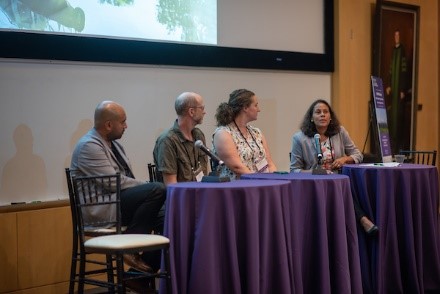
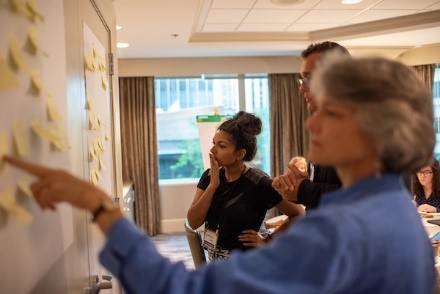
Figures: Convening discussion about sustainable urban systems at SUSPIRE, July 2019
Transforming built environments through structures that provide renewable and waste thermal energy from the building to the city scale
Posted; November 13, 2019 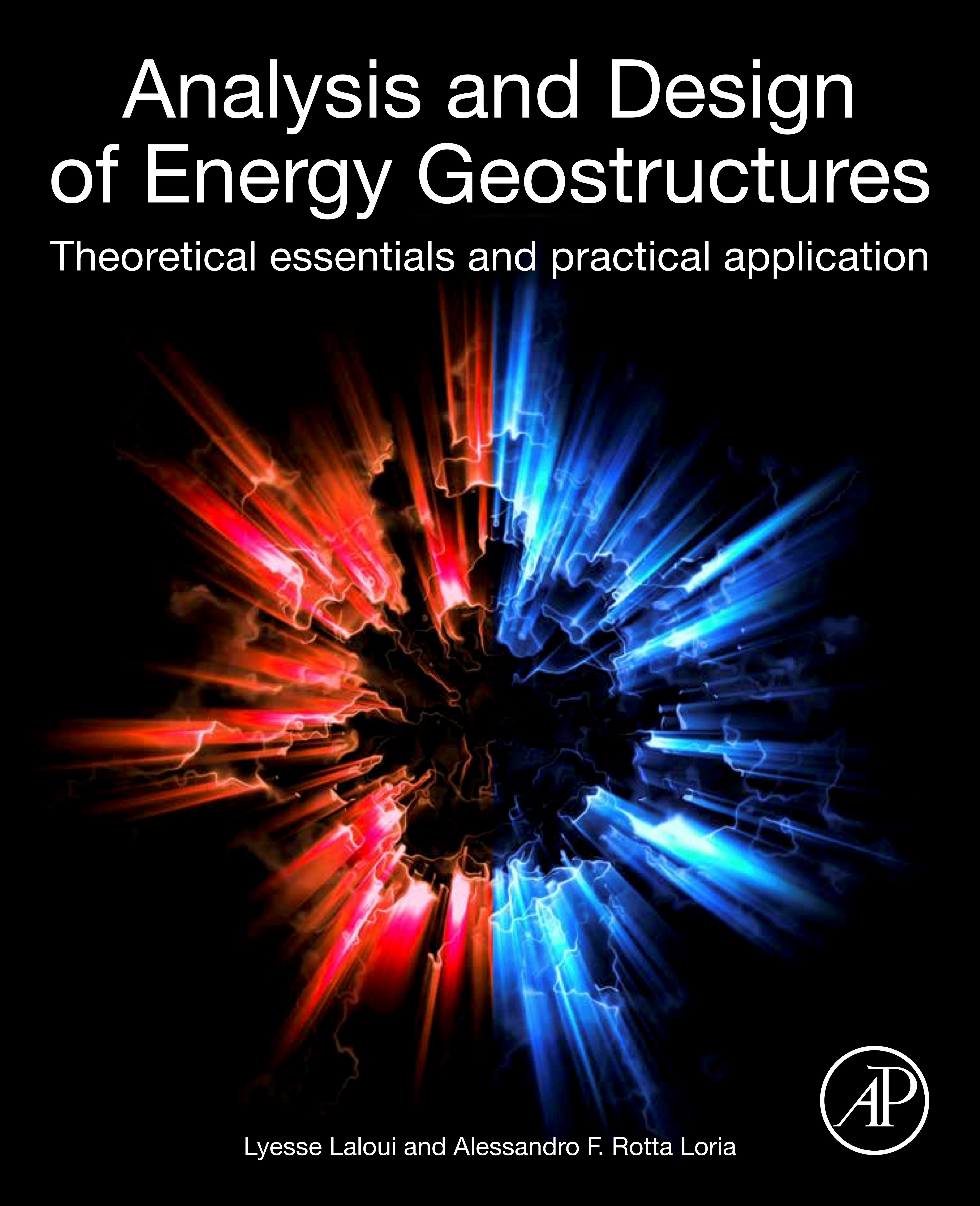
Alessandro Rotta Loria, Assistant Professor of Civil and Environmental Engineering
As the Director of the Mechanics and Energy Laboratory within the Department of Civil and Environmental Engineering at Northwestern University, I’ve co-authored a new book entitled “Analysis and Design of Energy Geostructures.” Briefly, transforming all structures in contact with the ground to provide structural support and thermal energy is the cutting-edge role of energy geostructures. A lot of renewable geothermal energy and waste thermal energy is readily available below the earth’s surface. Typically made of reinforced concrete with embedded plastic pipes with circulating water, energy geostructures allow the transfer of the previous thermal energy sources from subsurface environments to buildings and infrastructures. In this way, the very foundations of constructions such as piles, retaining and diaphragm walls, slabs and barrettes, as well as other underground structures such as tunnels, are transformed into so-called energy piles, energy walls, energy slabs, energy barrettes and energy tunnels. The renewable geothermal energy and waste thermal energy that is captured from energy geostructures can be used from the building- to the city-scale for a variety of purposes. These include space heating and cooling as well as hot water production. Meeting such considerable energy requirements of buildings and infrastructures through the harvesting of renewable and waste thermal energy sources, while providing structural support, makes energy geostructures a powerful technology to sustainably revolutionize the built environment.
This new book describing the science and engineering of energy geostructures is the first of its kind. My co-author is Professor Lyesse Laloui, Director of the Laboratory of Soil Mechanics of the Swiss Federal Institute of Technology in Lausanne (EPFL). He is widely considered to be a pioneer in the research and development of energy geostructures. We have designed this book with several important features. First, the book crosses disciplines so that readers can analyze and design energy geostructures from energy, geotechnical and structural perspectives. Second, it serves as a source of broad theoretical and experimental competences pertinent to civil, environmental and energy engineering, geology, architecture, and urban project management. Finally, the book provides various resolved application exercises to test the understanding of the covered subjects.
Evolving and building globally for approximately twenty years, the science and engineering of energy geostructures has been continuously and increasingly in the spotlight across the fields of Geomechanics, Structural Mechanics and Energy. Our new book aims to provide critical competences that present and future generations of scientists and engineers need to acquire for resolving urgent environmental and societal challenges associated with the built world. It represents an example of the efforts pushing the current knowledge boundaries in the fields of environmental sustainability that are undertaken within the Center for Engineering Sustainability and Resilience at Northwestern University.
References
